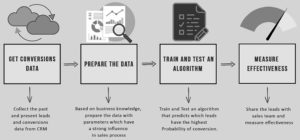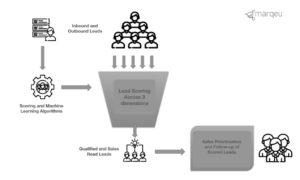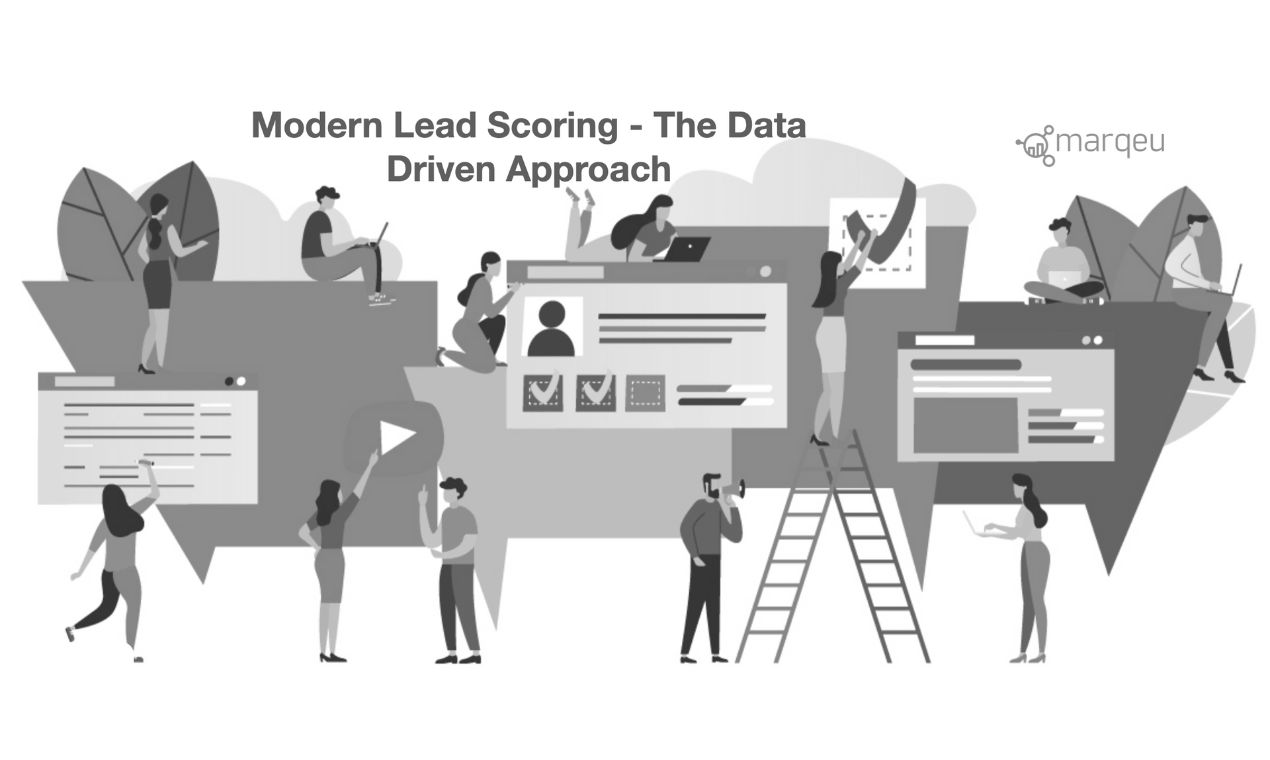Modern Lead scoring is an essential aspect of modern data-driven B2B marketing, which helps sales and marketing teams to actively prioritize their leads based on their likelihood to convert those qualified leads into revenue-generating opportunities. With the right lead-scoring strategy, marketers can identify the most promising leads, rank their likelihood to convert based on an exhaustive group of data points and optimize their efforts to maximize conversions and revenue. Lead scoring is the process of assigning a numerical value to a lead based on its attributes, behavior, and other relevant factors.
At marqeu, our approach to lead scoring is powered by a detailed analytics and reporting process to enable marketers to continuously track and fine-tune the lead scoring model on an ongoing basis. We tend to lean towards the other side of “set-and-forget” when it comes to managing lead-scoring algorithms. Designing the lead scoring framework is an extremely data-intensive step-by-step process where alignment with sales teams is extremely important.
To make the most of such data points provided by the modern marketing tech stack,
we have designed a 3-dimensional lead scoring framework, which takes into account the demographics and behavior of the engaged leads to decide when they are ready for a conversation with sales teams and when it is appropriate to move such leads into nurture streams.
Both engagement and firmographic scores in turn are derived from a wide range of data sources including responses to both inbound and outbound marketing campaigns (both 1st and 3rd party), website engagements, intent data, etc. A combination of these 2 dimensions gives the 3rd dimension, which is the actual lead score that is used to prioritize engaged leads for follow-up by the sales or telemarketing teams.
Our approach to lead scoring is powered by a completely customizable algorithm that is built to make sure that every lead, which engages with marketing campaigns is qualified on the 2 fronts.

Once the individual scores across these dimensions are calculated, we then roll up these scores into quadrants by normalizing them into 4 categories to make it easy for the sales teams to prioritize the follow-up activity. These 4 categories are:
- A: hot leads. These are highly engaged leads that are closely aligned with the ideal buying persona. These leads hold the highest priority when it comes to follow-up by sales teams.
- B: highly engaged leads which are not very closely aligned with the ideal buyers’ persona
- C: closely aligned persona leads (from target accounts) with the ideal buyer persona who may not be highly engaged or showing buying behavior yet.
- D: Last priority is the leads in the marketing database who may or may not have engaged yet.
We have been building advanced lead-scoring algorithms for the past 8+ years as part of our advanced marketing analytics service offerings for some of the most innovative organizations and this priceless experience has equipped us with unparalleled expertise when it comes to building custom lead-scoring algorithms. In collaboration with our diverse customer base and phenomenal growth minded marketing leaders, we have developed algorithms and frameworks that are easy to implement, understand and more importantly, they empower marketers when it comes to discovering insights about what tactics, and channels are helping generate qualified leads that have a higher probability to convert to qualified sales opportunities at faster rates. Based on our experience,
here are the core capabilities and features of best-in-class lead-scoring algorithms:
Deep understanding of the buyer persona their actions and engagements that signal to buy intent. Consensus with the sales organization on these definitions and their weightage when it comes to lead scores. The first step in designing the lead scoring program is to define an ideal customer profile (ICP). This includes identifying the key characteristics of the ideal customer, such as industry, company size, location, job title, and more. By defining the ICP, we can ensure that we are targeting the right leads likes of which have shown the highest probability of driving qualified sales opportunities.
Robust data gathering in marketing automation platforms, CRM, and other platforms in the tech stack. We start with identifying the deals that the organization has closed over the past 2 years. Within those accounts, we identify the contacts that have engaged with the marketing campaigns, key decision makers, and “contact roles”. We then analyze their marketing engagement history and their firmographic data to put together the ICP. There can be multiple ICPs.
A heat-map view of the marketing engagements by the ICP helps us understand which marketing channels and offers are resonating the most with the ICPs.
We also review how the organization has been weighing those offers and channels in the existing lead-scoring algorithms to understand to what extent the existing algorithms are aligned with the behavior of the ICPs from won accounts. This exercise helps set the baseline of the performance and provides key data points to work with when it comes to optimizing the lead scoring model.
Intent data can be a powerful tool for improving the accuracy and effectiveness of lead-scoring algorithms. Intent data refers to information about a lead’s behavior and activities that suggest they are in the market for a particular product or service. Tools like Demandbase, and 6Sense have been providing this information about the intent and buying signals to help augment the behavior/firmographics data that is being used in the traditional lead scoring algorithms. Intent data can help identify leads who are actively researching the service offerings, indicating a higher level of intent to purchase. By prioritizing such leads in lead scoring algorithms, we can ensure that the sales team focuses their efforts on the most promising prospects.
Given the growing focus on ABM across all the marketing organizations, we also recommend taking into consideration leads from the target/ABM accounts
who are engaging directly with the campaigns or have been identified via intent data to be of higher values based on the alignment with ICP. These leads are usually scored higher to make sure sales reps are alerted of any engagements from such leads/accounts.
Designing workbooks and simulations to demonstrate how the proposed lead scoring would work in the real world to measure the impact of every single data point towards qualifying a lead for follow-up with the sales teams – we have seen these simulations do the magic when the stakeholders can see tangibly lead scoring work. Building, testing, and deploying the actual lead scoring model in a marketing automation system.

Documentation and training for the teams so that they have a complete understanding of the lead scoring algorithm and can differentiate between the leads with different scores.
Regular review of the models by advanced data analysis of the scored leads (and their follow-ups) to continuously optimize the system and align with the feedback from the sales executives on the qualified leads.
Machine learning and AI algorithms can analyze large amounts of data and identify patterns that humans may not be able to detect. This can improve the accuracy of lead scoring by identifying the most relevant and engaged leads,
even if they exhibit unexpected behaviors. Predictive scoring uses historical data and machine learning algorithms to predict which leads are most likely to convert into customers. This can help sales teams prioritize their efforts and focus on leads that are most likely to result in closed deals.
We are always on the lookout for inputs and examples from the marketing community to keep adding value for our customers. We welcome inputs from other growth marketing leaders and marketing operations practitioners around the approach to lead scoring strategy at their organizations. What data points are you using to score leads and track the performance of qualified leads through the funnel at your organizations?


